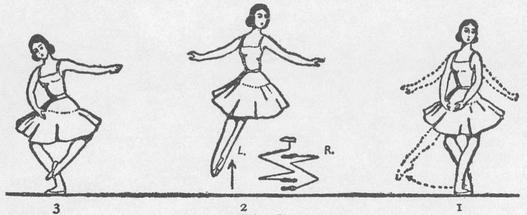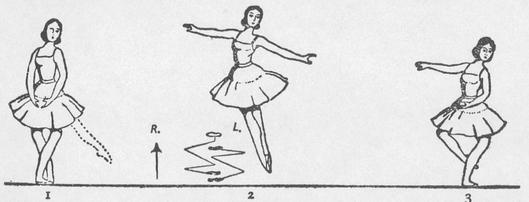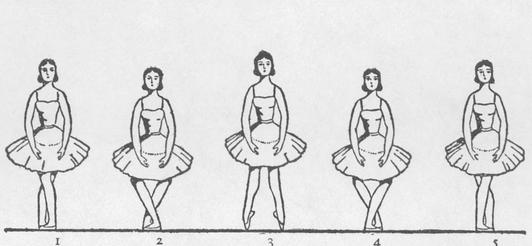Basic Principles of Classical Ballet (21 page)
Read Basic Principles of Classical Ballet Online
Authors: Agrippina Vaganova

The directions, between points 2. and 3 for the movement forward, and between points 6 and 7 for the movement backward, must be rigidly enforced in order to produce a clean brisé. If one moves just diagonally, the brisé will have a careless, unfinished look, because the legs will not manage to cross over sufficiently and will only touch each other with the heels.
The arms in bris6 take the following positions: during the upward flight the arms open to the side in the 2nd position, at the end of brisé forward the right arm is in 1st position and the left one in 2nd position. Only at the end the left arm can be in 1st position and the right one in 2nd. In both cases the arms should not be higher than 45°.
2. Brisé dessus. The movement begins in the following manner: 5th position, left foot front; demi-plié, right leg glides and is thrust out into 2nd position, beats front on left calf; open legs and lower yourself on right leg in demi-plié, left leg sur le cou-de-pied front.

91. Brisé dessus
It is customary to follow this by brisé dessous: left leg opens through 5th position into 2nd position, beats back of right calf; open legs and fall on left leg in demi-plié, raising right one sur le cou-de-pied back.
Brisé dessus is done moving forward, brisé dessous moving backward.
In brisé the body has a slight play. Namely, in brisé the body bends and unbends forward and backward depending on the movement. In brisé dessus the body should be bent toward the right hip, in brisé dessous—to the left hip. The head moves in the same manner.

92. Brisé dessous
The right arm is bent, the left one opened to the side; at the moment of changing from one brisé to the other, the arms also change—the right arm opens, the left one bends when the head is bent to the left.
IX
POINT WORK
STRICTLY SPEAKING, pointe work is dancing on the extreme tips of all toes of the foot, the arch of which is extended.
There are various forms of pointes, however, and they depend on the construction of the foot of the dancer. The most comfortable for dancing on pointes is a foot the toes of which are of equal length, as if “chopped off”, with a low arch and a solid, strong ankle.
The foot which we consider beautiful in everyday life, i.e. one with a high arch, a well-turned, slim ankle, correctly grouped toes, makes it difficult to execute movements on pointes, especially those movements which require jumps on pointes. However, even though such a foot cannot be placed on all toes, as required by the rules of ballet, it can be helped by diligent work toward a greater turn-out, so that the foot is supported by as many toes as possible, and does not rest with its full weight only on the big toe.

93. Pointes
In so far as pointes are concerned, the Italian technique has such unquestionable advantages that I subscribe to it without reservations. Cecchetti taught the dancer to rise on the pointes with a little spring, distinctly pushing off the floor. This manner develops a more elastic foot and teaches the concentration of balance of the body on one spot. The French manner of rising on the pointes smoothly from the very beginning of the training removes the possibility of technical perfection.
For the beginner it is difficult to rise on the pointes with a spring; for instance, to spring into 5th position on pointes. It would seem easier to rise on the pointe of one foot from a running start. Anybody can easily do that, but this manner of rising on the pointes is aimless. At the beginning one should carefully learn to rise correctly on the pointes of both feet in order fully to strengthen the tendons of the heels; a casually chosen manner of doing the movement will only make it more difficult for the pupil to learn the correct method.
Beginners should start the first study of pointes at the barre. Face the barre and put both hands on it so that the wrists touch, then begin by rising on the pointes in all positions, pushing off the floor with the heels before each movement. Under no circumstances should the beginner jump on to the pointes, before the tendons of the heels have been strengthened.
In centre practice the following order should be observed:
1. Temps levé on both feet. Stand in 1st position, demi-plié, push off with the heels, and with a little spring rise on the pointes; lower yourself in demi-plié, paying attention that the legs are fully turned out, and continue. The same movement is done in 2nd and 5th positions.

94. Sus-sous
If temps levé is done from 5th position into 5th position while moving with a small jump forward, back or to the side, the step is called sus-sous. At the instant of rising on the pointes the feet must be tightly closed, one behind the other, so that they make the impression of one foot. Properly executed, this step gives the dance a well-finished form.
2. Échappé on pointes. Demi-plié in 5th position, push off with the heels, and spring into 2nd position on pointes, lower yourself back into 5th position in demi-plié, One may finish in 5th position with a change of feet. In doing échappé in croisé and effacé, the movement is done from 5th position into 4th position.

95. Échappé (on pointes)
3. Glissade. Stand in 5th position, right foot front; demi-plié, slide the point of the right foot to the side and step out onto the pointe of this foot, and quickly bring the left foot, also on pointe, into 5th position. Lower into 5th position in demi-plié.

96. Glissade (on pointes)
4. Temps lié. Stand in 5th position, right foot front, both arms in 1st position; demi-plié, the point of the right foot glides forward into croisé, left leg remains in plié. Step onto the pointe of the right foot, changing left arm from 1st position up into 3rd position, the right arm to the side in 2nd position, and pull left leg, also on pointe, into 5th position back. Lower yourself into demi-plié (facing the audience) in 5th position, changing left arm to 1st position; slide the point of the right foot to the side into 2nd position, move left arm to the side and leave left leg in plié. Transfer the weight of the body to the right leg, onto the pointe, pull left leg, also on pointe, into 5th position front, changing right arm up into 3rd position. Lower yourself into 5th position in demi-plié and lower arms into preparatory position. Repeat the whole movement starting with the left foot. The same movement is also done backwards. The head moves in proper épaulement.

97. Temps lié (on pointes) 1st part

